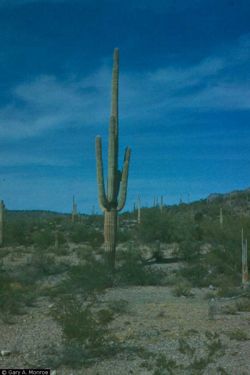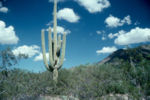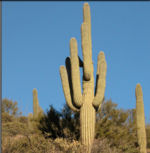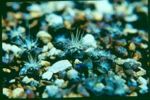Saguaro
| Saguaro |
|---|

|
| Scientific Classification |
|
| Binomial |
| Carnegiea gigantea |
| Synonyms |
| Cereus giganteus |
The Saguaro (Carnegiea gigantea) is a species of cactus. It is the largest variety of cactus in United States. Its habitat is Arizona, California, and Mexico and is very abundant in these areas. Sometimes Saguaros gather together and form a "cactus forest" in a desert.
The Saguaro lives in hot and dry climates, usually in deserts. It requires reasonable amount of water per year.[1] In addition, it is very tolerable to varying temperatures. It can survive in temperatures as low as -4 °C, while other cacti from northern areas. The Saguaro is the state symbol of Arizona and because of this habitat it is also recognized as the symbol of the American Southwest. The Saquaro is common in Sonoran Desert (Mexico) or around the Tucson and Phoenix areas. [2]
Anatomy
Saguaro grows slowly, about 2cm annually. After it grows about 2 to 3m it then changes this pattern and grows about 10cm annually. When it lives about 50 to 75 years the Saquaro develops side shoot. It can bloom flowers and lives lives for about 150 to 200 years, sometimes even more than 200 years. When Saguaro stops growing, its height is about 15m and 3m width. [3]
Saguaro cactus is tall plan with a long and strong structure, with woody tissues that run parallel with cylindrical shape. In the woody tissues there is a thick pitch. The soft tissue is used for storage as well.[4]
Saguaro cactus can survive from desert well, because it can store massive amount of water. The reason is that the cactus has great root system. (Root goes down up to 50feet under ground in all directions, so it is easy to gather water from the ground.) Water is stored in soft tissue. Saguaro is covered with waxy skin, because the waxy skin protect from losing (evaporating) water. [5]
Saguaro cactus covers by smooth and waxy skin. The spines, which are modified from the leaves, are located on the tree. The spines help Saguaro to cool down the outer skin. Also, they help wind to redirect the cactus. Even though the spines help wind to redirect the cactus, sometimes it is taken out by wind.
When Saguaro cactus is about 50 to 75 years, it blooms the flowers in May and June. The flowers are white or creamy white with yellow center. The flowers bloom at the end of the branches. [6]
Reproduction
When Saguaro cactus is about 50 to 75 years, it blooms the flowers in May and June. Many bats and insects are carrier for pollination. Saguaro cactus attracts the animals or the insects with nectar. Some flowers of the cactus look like the insects, so they attract the insects. Woodpeckers come to the cactus for habitat. When the animals and the insects come for food or habitat, they pollinate the cactus. Saguaro cactus produces millions of seeds, but there are few chances to survive. Only few of them will germinate and grow. Saguaro cactus’ seeds are really small and black, and germinate within 5 days with late summer rains. [7]
The flowers open during evening and stay until the next day. The flowers are blooming from at the top of branches or side of branches. The size of the flowers is mostly small. The flowers are 10 to 12cm long, and 9 to 12cm in diameter. Cactus has many colors of flowers except blue color. [8]
Ecology
Saguaro cactus is a “symbol” of desert since many years. Because the cactus became “symbol of desert”, it also became a host for the desert Saguaro can survive well from desert compare to other plants. It can store water well, and it is coated with waxy skin to protect losing water from hot weather. Therefore, cactus is very suitable plant from the desert. [9]
Saguaro grows well from harsh weather and harsh environment. It lives from rocky soil of desert. Sometimes Saguaro dies by environmental damages. Saguaro dies by wind, so it can be taken out from ground. Some of Saguaro dies with cold weather. Even though Saguaro is tolerated with temperature, still it cannot live from cold weather. When temperature goes down below -4 °C, Saguaro cannot live.[10] Saguaro is consumed by human and animals for many reasons. It can be food production, material for house or objects, and habitat. Right now, Saguaro is protected by the United States government with the laws, because Saguaro cactus is disappearing. There is one park, Saguaro National Park, is protecting the cacti. [11]
History
Fossil records showed that cactus might be existed about 9000 years. Cactus was introduced to Europe first time by Christopher Columbus in 15th century. In 17th century, scientists became interest in the cactus. Carolus Linnaeus, who was a great botanist and had created the universal plant system, named “kaktos”. Nowadays, kaktos is called as cactus in English version. [12]
Since 20th century, the cactus became more popular in the United States, and the species of it are growing steadily. United States is protecting the cactus by the law, and the cactus is one of state symbol for Arizona. Even though United States is protecting the cactus, it is not welcomed in Mexico. For example, a sentence for a prisoner is pulling out cactus from ground. In the present, many cacti were pulled out from the ground in Mexico. The number of the cacti is declining, and their habitats are destroyed. [13]
Right now, Saguaro is protected by the United States government with the laws, because Saguaro cactus is disappearing. There is one park, Saguaro National Park, is protecting the cactus. [14]
Usage
Saguaro is very useful source in desert to human and animals. It is used in many ways to to local Indians (Papago and Pima Indians). Saguaro cactus bears edible fruit, which is red, so it is important food production to the Indians. [15] Every single part of cactus is very useful to human. Fruit of cactus is used for food production. The fruit makes wine or it is eaten as itself. Fiber of cactus is used to make baskets, blankets, clothes, bags, ropes, sandals, sometimes papers. Sometimes cacti are used for making house. [16]
Not only people but also many animals consume the Saguaro cactus. Long-Nosed bat, bees, wasps, ants, and butterflies drink nectar (Sugary water, which is produced from the flowers to attract the animals or insects for reproduction) from cactus’ flowers. The animals use Saguaro for food production, but also it used for habitat. Woodpeckers, especially, Gila woodpeckers, live in the cactus. It makes the holes on the cactus. The Gila woodpeckers use the holes as their nests. Because of the woodpeckers, some of the cactus are dying. When the woodpeckers make the holes, they break the pith (which stores water), so the cactus cannot support water. [17]
References
- SAGUARO (Carnegiea gigantea) The University of Edinburgh
- Saguaro Cactus Blue Planet Biomes
- Saguaro National Park The American Southwest
- Saguaro National Park Shannon Technologies
- A Brief History of Cacti Dune Craft Inc.
- Saguaro, Sahuaro Desert Tropicals. Com
- Saguaro Wikipedia
- Cactus Wikipedia




